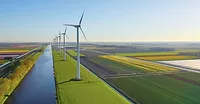Corrosion Protection With ICPS: Mechanism, Stability and Durability of the Protective Component
It is important to stress that chemical activity is mainly observed with non-doped conducting polymers, i.e., purely organic, non-charged species, with the latter being also not electrically or electronically conductive. On the other hand, electrochemical corrosion protection of conducting polymers is discussed in context with so-called active/passive metals and limitation of such activity is to the (doped) electrically conductive versions of conducting polymers, i.e., organic polymer salts of extreme brittleness and other typical salt-like properties.1
Indeed, the scientific discussion on how doped conductive polymers effect corrosion protection appears quite confusing and stimulated by misleading information from commercial distributors of conducting polymers.2 Basically, electrochemical corrosion protection of such kind means passivation of the corroding metal surfaces, i.e., anodic stimulation of metal dissolution until the crucial corrosion rates of the metals are exceeded, accompanied by the formation of a very thin (10 nm for steels) protective metal oxide layer.3
Based on this feature of electrochemical corrosion protection, the conducting polymers must act as corrosive materials on the metals to be protected in the first place. However, this would end up only in increased metal dissolution, if the composition of the conducting polymer does not allow for a mechanism to form the protective oxide layer at some critical dissolution (corrosion) rate. Thus, it is clear today, too, that the conducting polymers cannot impose electrochemical corrosion protection on their own, but rather only in combination with auxiliary substances, such as nitrite, phosphate and other environmentally friendly substances.4,5
Accepting these properties of conducting polymers, one would be able to create corrosion protection materials, which are environmentally promising as potential substitutes for lead and chromium(VI) pigments. Unfortunately, this straightforward conclusion is blocked so far by basic physicochemical properties of most of the state-of-the-art conducting polymers, in particular the polyaniline and polypyrrole families. The latter conducting polymers normally need acidic conditions to keep their electrical conductive state alive. In particular, polyaniline and its VERSICON®, ORMECON®, PANDA® and CORREPAIR® versions need a pH value of at least 1 to be reasonable electrically conductive.6
The need to keep conductive polymers at such a low pH value has serious impact on potential corrosion protection processes. First, corrosion protection with such materials takes place in the heavily acidic regime, where normal oxygen corrosion is superimposed by the well-known hydrogen corrosion. Second, oxygen and other molecules (coming from the environment of the corrosion spot) might get extraordinary high oxidation power under acidic conditions. A good example for such a molecule is the nitrate ion, which has an oxidation potential of about 1 V standard hydrogen electrode (SHE) under acidic conditions and simultaneously produces even more oxidative NO2 and NO species. Third, drying an acidic solution of pH = 1 (i.e., the wet corroding metal/conducting polymer interface) automatically means an increase in concentration of that acidic solution, ending up with concentrated acids and mixed acids, with even higher oxidation strength (cf. oxidation potentials of concentrated sulfuric acid and nitric acid solutions). Therefore, oxidative stability of the respective conducting polymers under acidic corrosive conditions becomes a key issue of the whole application.
Another important issue of anti-corrosive applications of doped conducting polymers concerns the protection mechanism involved, i.e., a reasonable molecular picture on how a basically corrosive material will end up as a corrosion protective one.1 As has been indicated already, complex processes between the number of ingredients at the corroding spot has an influence on the resulting phenomena. Some persons, not necessarily specialists in corrosion protection, claim that the simple separation of the anodic and cathodic spots of the overall corrosion process is responsible for the observed protection effect. However, such explanation cannot explain protective effects, because separation of both reactions would preclude metal oxide formation (passivation) in the first place. In other words, with OH ions being produced far away from the metal, ions cannot result in the formation of a well-adhering oxide layer on the metal surface. Moreover, ion concentration effects accompanied by such separation will automatically result in “osmotic” delamination of the conducting polymer material from the metal surface (bubble formation).
Consequently, the current research project focused on the evaluation of the chemical/electrochemical stability of doped conducting polymers under corrosion protective conditions. Emphasis was made (in this early approach) on nitric acid solutions of different concentration. Addition of ammonium nitrate (a fertilizer) and ferric ions (remember passivated steel corrodes with release of ferric ions) was attempted to identify alternatives and variations in the (potential) degradative behavior. Mechanistical studies involved estimation of surface and mixed potentials of diverse steel and conducting polymer samples in a variety of test solutions.
Figures 1 and 2 show the results of chemical and electrochemical degradation experiments of nitric acid solutions of different concentration and different amounts of ferric ions present. Obviously, chemical and electrochemical degradation of the PANDA-polyaniline is easily effected under the conditions used, with a faster degradation effect observed when electrical contact in between the PANDA and a passivated steel surface (stainless steel 316) is present. Moreover, degradation of the PANDA does also extend into the pH-regime of pH >1 and only “trace” amounts of ferric ions present. Moreover, and not included in the figures, it was found that chemical deactivation (i.e., complete loss of electrical conductivity) of the PANDA material could be obtained by only 7x10-4 mole of (NO)x species.
Figures 3 and 4 show test bars of degradation experiments on PANDA and Correpair polyaniline in 1 M HNO3 and 1 M HNO3 + 1 M Fe3+ (from ferric sulfate) after exposure times of one and two weeks, respectively. Complete degradation of both polyaniline materials is pretty obvious indicating that nitric acid solutions of pH = 0 (occurring on wetting/drying when using these polyanilines in nitrate containing soils) are going to decompose the potential corrosion protection material “polyaniline” in a very short while. Figure 5 shows a plot of the mixed potentials of diverse galvanic corrosion experiments in between plain carbon steel and the respective ICP material. Obviously, most of the ICP materials checked can impose some beneficial anodic polarization in the “standard” test solution, i.e., 0.1 M HNO3 + 3.5 wt.-% K2CrO4, the reason of which and the protection mechanism involved is detailed in the research report, which can be obtained from the author.
This article is based on a study conducted by the author, and is reprinted by permission of the copyright holder. A copy of the report can be obtained from Frank Lux, Calvinstr. 14, D-10557, Berlin, Germany; phone +49-30-391-51-39; e-mail 101710.2125@compuserve.com.
Looking for a reprint of this article?
From high-res PDFs to custom plaques, order your copy today!







